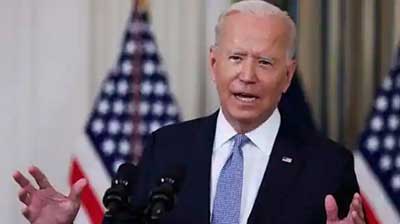Relevance: GS-2: Bilateral, regional, and global groupings and agreements involving India and/or affecting India's interests
Key Phrases: Asia-Pacific region, Economic framework, East Asia summit, Neo-imperialism, Trans-Pacific Partnership, Regional Comprehensive Economic Partnership, QUAD, AUKUS.
Why in news?
- The U.S. president unveiled the idea for the new economic framework during the East Asia summit in October 2021 and is expected to roll out details in the weeks ahead.
- The U.S. administration is preparing to unveil its first broad economic strategy for the Asia-Pacific region, a move awaited by U.S. allies and American business groups that are uneasy about China’s expanding influence in the region.
Why is such policy needed?
- The Centre for Economics and Business Research (CEBR) said in an annual report published on 26th December 2020, that China will be the world's biggest economy by 2028 by overtaking the US. China's growing influence in the Indo-pacific region is becoming a huge concern for the U.S.
Growing Influence of China:
- China’s economic diplomacy: The New Framework comes as China beefs up its Economic Diplomacy in the region. China in recent months applied to join The New Iteration of The TPP And The Digital Economy Partnership Agreement, an alliance between New Zealand, Chile and Singapore viewed as a model for future Digital-Trade Agreements.
- China’s Expansion Policy: China is creating a neo-imperialism in the world. For example, China will take the ports of Sri Lanka for 99 years because of Sri Lanka not able to debt repayment. The borrowing was done by Sri Lanka for development.
- China’s regional hegemony: China is also heavily promoting its role in The Regional Comprehensive Economic Partnership, A 15-Nation trade agreement launched last month.
Beijing’s pro-trade steps have fueled concerns among American businesses and close allies. They worry that the U.S.’s absence in regional trade agreements gives Beijing an opening to establish its leadership in setting rules and standards for trade and economy, particularly in emerging technologies such as artificial intelligence and digital trade.
While the new economic strategy for the Asia-Pacific region by the U.S. is to counter China’s growing influence, it also underscores the significance of the Indo-Pacific region.
“The Indo-Pacific region is a critical part of our economy. It’s not just that it accounts for over half of the world’s population and 60 percent of global GDP, seven of the top 15 U.S. export markets are in the Indo-Pacific.
Two-way trade between the U.S. and the region was over $1.75 trillion” Jose Fernandez, the undersecretary of state for economic growth, energy, and the environment, said in a recent briefing.
Vision of the New Indo-Pacific Economic Framework:
- Broadening the areas of trade: With the new Indo-Pacific Economic Framework, the U.S. aims to work more closely with friendly nations on issues including digital trade, supply chains and green technology.
- Filling the vacuum of US absence: The framework is aimed at filling the hole in U.S. Asia strategy left by its 2017 departure from the Trans-Pacific Partnership, a robust trade agreement the U.S. had helped to design as a counterweight to China.
- Market-Access Measures: These are considered essential to building stronger U.S. relations in the region, particularly with less-developed nations in South and Southeast Asia seeking to sell more agricultural and manufacturing products in the U.S. Market.
- Need of a New Era ties: Without a Comprehensive Economic Strategy, the framework could simply become another club for the U.S. and its rich allies like QUAD, AUKUS etc. A significant step in U.S. efforts to move beyond security ties to counter China’s growing ambitions in Asia.
- Diverse and Inclusive Agreement: The Framework will be structured as a collection of Individual Agreements, which nations in the region can pick and choose to sign up on. It will likely exclude tariff cuts and other legally binding market-opening steps that require Congressional Approval.
Though the framework is viewed as strengthening the U.S. global position in the long term, it is facing some challenges as well.
- President Biden isn’t expected to offer tariff cuts and other traditional market-opening tools to trading partners, which are opposed by U.S. labor groups and their Democratic allies as well as some Republicans on grounds that they come at the expense of U.S. jobs and manufacturing.
- How to include Indonesia and Vietnam: These are the countries that are going to be cautious, that are going to take a wait-and-see approach to see how it evolves entering these kinds of commitments.
Way ahead:
- Find a correct balance: In putting together the strategy, the administration must find a balance between the demands of the trading partners, U.S. businesses and labour, and the progressive wing of the Democratic Party.
- Ensuring data security and privacy in digital agreement: The U.S. has thus far failed effectively to regulate the tech sector at home to ensure that consumer privacy rights are protected.
- Digital trade in central focus: Digital technology will help in ensuring U.S. leadership in emerging technologies like artificial intelligence and 5G, so digital agreement must be “front and center” of the broad strategy.
- Competitive parity with China: To attract the countries in the region and provide them with a viable alternative.
The U.S. wants to counter China’s influence around the world by providing everything from infrastructure to vaccines and green energy and this new Indo-Pacific Economic Framework is an incredibly important aspect of the U.S. effort to ensure a free and open region.
Sources: wsj com
Mains Question:
Q. How the New Asia-Pacific Economic Strategy by the U.S. is expected to counter China’s growing influence. [250 words]









